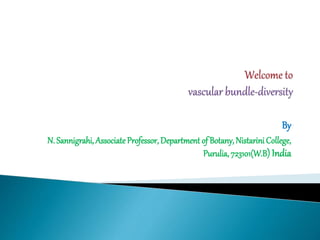
Vascular bundle diversity
- 1. By N. Sannigrahi, AssociateProfessor, Department of Botany, Nistarini College, Purulia, 723101(W.B)India
- 3. All land plants need conducting tissues to transport water, minerals and organic materials from the source to sink inside the plant body. The tissues having conducting strands constitute the vascular system of plants. The vascular bundles originate from primary meristem. According to Hanstein and Schmidt plerome and corpus respectively give rise to vascular bundles along with other non-vascular tissues. Haberlandt (1914) called the meristem of vascular tissues as procambium that divides longitudinally. The peripheral derivatives form phloem while the inner forms xylem. The first cells of xylem to mature are termed as protoxylem whose development may be centripetal or centrifugal or both in relation to the centre of axis of the organ and respectively termed as exarch, endarch and mesarch.
- 5. The former two are the characteristic of root and stem respectively while mesarch arrangement is found in the stem bundles of Pteris and ferns. The lately formed xylem is termed as metaxylem. Protophloem is the first cell of phloem to mature and their development is acropetal in relation to the centre of axis of organ. The lately formed phloem is termed as metaphloem. Vascular tissue transports water, minerals, and sugars to different parts of the plant. Vascular tissue is made of two specialized conducting tissues: xylem and phloem. Xylem tissue transports water and nutrients from the roots to different parts of the plant, and also plays a role in structural support in the stem. Phloem tissue transports organic compounds from the site of photosynthesis to other parts of the plant. The xylem and phloem always lie adjacent to each other in a vascular bundle .
- 6. Xylem and phloem constitute the vascular bundles. The xylem of two types-protoxylem and metaxylem. Protoxylem are early formed xylem in comparisons to metaxylem. Protoxylem derived from procambium. In exarch condition, metaxylem remains towards the centre and in endarch, the metaxylem remains toward the centre. Similarly, protophloem and metaphloem derived form the same direction . The vascular cambium composed of two types of cells-uniform initials having elongated structure and ray initials having more or less isodiametric. The primary growth is brought about by primary vascular bundles and the secondary growth is achieved by the secondary cambial due to the addition of secondary xylem and secondary phloem respectively.
- 7. a) Closed collateral bundle: In this type cambium is absent in between xylem and phloem. Therefore stems having this type of bundle do not have normal secondary growth. Ex. Monocotyledonous stem. Usually these bundles are enclosed within bundle sheath made up of sclerenchyma and those that lack the sheath are considered as anomalous (e.g. Asparagus stem). b) Open collateral bundle: An open collateral vascular bundle has cambium called fascicular cambium between xylem and phloem. The bundles can increase in diameter by normal secondary growth with the help of fascicular cambium. Ex. Dicotyledonous stem.
- 8. Type 2. Bicollateral Bundle: A vascular bundle with phloem situated on the peripheral and inner side of xylem is known as bicollateral bundle. A strip of cambium termed outer cambium is present between the peripheral phloem and xylem; another strip of cambium, termed inner cambium, is also present between inner phloem and xylem. The peripheral or external phloem is termed as outer phloem whereas the inner or internal phloem is called inner phloem. The sequence of vascular tissues in the bicollateral bundles from periphery toward centre is outer phloem, outer cambium, xylem, inner cambium and inner phloem.
- 9. These bundles are open type as strips of cambia are present but the secondary thickening occurs only by the outer cambium, i.e. cambium present between the outer phloem and xylem. Ex. Cucurbita Concentric Bundle: A vascular bundle in which one type of vascular tissue surrounds the other is known as concentric bundle. In this bundle xylem either encircles or is encircled by phloem and accordingly the following two types are recognized: (a) Amphivasal bundle: A vascular bundle in which xylem encircles the central strand of phloem is known as amphivasal bundle, also called leptocentric bundle. Ex. Dracaena, Yucca.
- 10. b) Amphicribral bundle: A vascular bundle in which phloem encircles the central strand of xylem is called as amphicribral bundle, also known as hadrocentric bundle. Ex. Selaginella. The concentric bundles, either amphivasal or amphicribral, are closed as there is no cambium in between xylem and phloem. Type 4. Radial Vascular Bundle: A vascular bundle, in which the primary xylem and primary phloem strands are separated from each other by nonvascular tissues and they are situated on alternate radii of an axis, is known as radial vascular bundle or radial bundle.
- 11. These bundles are the characteristic of roots. There is no primary cambium in this bundle and the secondary thickening occurs by the secondary cambium that originates at the time of secondary growth in dicotyledonous root only. The dicot roots usually have four to six number of protoxylem poles in contrast to monocot root where many poles of xylem (more than six) are present. The number of protoxylem poles in a root may be 1, 2, 3, 4, 5, 6 or more. Accordingly they are called monarch, diarch, triarch, tetrarch and so on.
- 13. The vascular system is a continuous system in two parts-stem and root and the parts are connected with the lateral expansions-leaves and branches. However, the skeleton differs in different plant organs which is constant as far as species is concerned. Every species has its own plant and arrangement of vasculature. The vascular skeleton shows increasing complexity from the first vascular land plants, Pteridophytes to angiosperms. The continuity of the vascular bundles from the aerial part to the underground parts are achieved by transition zone with orientation, splitting, swing of the vascular elements occur.